Canadian spruce Konica
One of the types of spruce - Canadian, can often be found under the name "Gray spruce": do not be confused by this feature. Indeed, this species differs from the usual European spruce in the light-gray color of the needles, which, moreover, are softer than those of “our” trees. And the "American women" also have a more compact crown, which has a very regular conical shape. When rubbed, their needles spreads a smell reminiscent of currant.
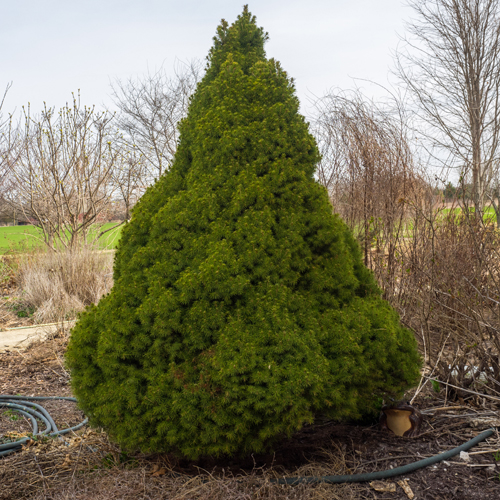
All Canadian spruces are very unpretentious, and in this component they give odds to the European (Norwegian) ones. It is not surprising that landscape designers have long paid attention to this species, created many varieties and cultivars on its basis. One of the most popular is the Konica spruce (Picea glauca Conica), which will be discussed.
Biography of our heroine
It began back in 1904, on the shores of Lake Laggan, in the province of Alberta (Canada). It was here that the unusual tree was found by Professor J.G. Jack with his partner Alfred Rehder. Unusual, because the spruce was tiny, with a very dense crown, although otherwise it practically did not differ from the rest of its "girlfriends".
The experts realized that they had stumbled upon an interesting natural mutation, and they were not mistaken. As it turned out later, the mutated tree had the same number of internodes as ordinary spruce, but it grew so slowly that it turned out so - the branches appeared on the trunk almost close to each other! So the gardeners of America, and later of Europe, turned out to be the owners of an interesting variety. It is good that the tree was noticed by experts, otherwise it would most likely have perished - nature does not like "freaks".
Description of appearance
It turns out that we have unwittingly already mentioned the main feature of the Konik spruce - its tiny size. Very rarely, it reaches a height of 3 meters, while its usual dimensions are about 1.5 - 2 meters in height and about a meter in width (at the lowest horizon).
Even this size in the garden will take a long time! As already mentioned, this species grows, as if in slow motion, increasing by 3-6 cm per year. The peak of growth occurs at the age of 8-15 years, after which its speed slows down noticeably. That is why in gardens and parks you rarely find this variety, which would be equal in size even to the height of a person.
Konica's crown is excellent: thick, narrow-conical, with ideal proportions. Its pubescent branches are slightly curved upward, have a light gray color, and the needles are soft, long, emitting a strong aroma. In short, if there is a perfect Christmas tree, then this is our heroine!
This beauty is completed by small neat cones that grow on branches usually in the upper third of the crown.

Varietal variety
Above we have described, so to speak, "classic Konica", but it should be said that for more than a century, breeders have tried to improve even such an exquisite, impeccable tree. On its basis, they managed to create several cultivars that differ from their parent. Here's a quick overview.
Alberta globe
Have you forgotten in which province the first Konik spruce was found? In 1967, a new mutation of the variety was discovered in the nursery of K. Streng Jr. (Netherlands), which was named after the Canadian province - the homeland of all Koniks. This variety differed from its parents in its crown: it turned out to be spherical. In addition, the needles were also surprising: short, soft and shiny. An adult "ball" does not even reach a height of a meter, which, however, did not prevent Alberta take a gold medal at the Dutch exhibition in 1968; because such a light prickly "hedgehog" is perfect for rockeries and rock gardens.
Albertiana
In fact, it is not a variety, but rather a variation of the standard Konica. It is bred by constant selection of specimens with a higher, but narrower crown. Her needles are sharper, and the cones are resinous.
Blue wonder
The brainchild of the legendary German kennel "Kordes and Sons", which was born in 1984, but received a trade patent only in 1999.This spruce differs from its parents mainly in the color of the needles, which is reflected in the name: in this variety it is dark green, to a slight blueness. In addition, this miracle with bluish needles grows even slower than the classic Konica.
Daisy’s White
Also another mutation found in 1979 in a Belgian nursery. Daisy White highlighted due to the unusual color of the new growth. Young needles are always yellowish at first, then gradually brightens, reaching almost creamy white, and only after one and a half to two months they acquire the usual green-gray color. Growth, like that of the previous variety, is less than the parental one.
Conica maigold
A novelty among all Koniks, only recently started to enter the markets. Very similar to the previous variety, with a young golden-yellow growth. But, unlike Daisy White, he does not subsequently turn green, the golden color simply becomes duller. Even at the end of the season, the cone of this spruce looks noble yellowish.
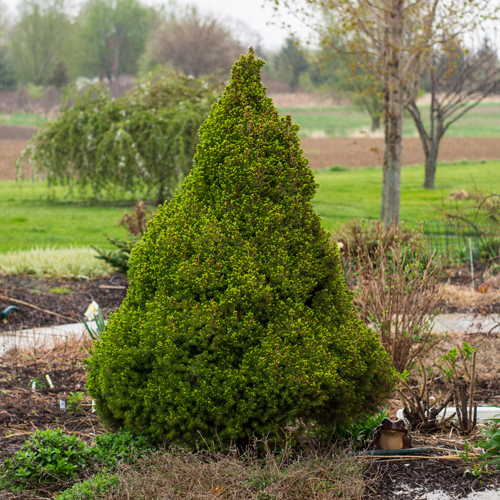
Conica baby
Also a novelty on the coniferous plant market! The name speaks for itself - the spruce is round, compact, usually no more than half a meter in height. In fact, its shape strongly resembles the Alberta Globe, but in a smaller version. In addition, the color of the needles is very light, almost whitish in youth, which makes the variety similar to Daisy White.
Care features
Now, having considered all the options, you can again go directly to Konik, because in terms of the features of agricultural technology, cultivars do not differ from their ancestor.
This spruce is quite persistent and unpretentious. She easily tolerates frosts below -40 °, especially at a more mature age. It tolerates constant shading, but in this case the crown looks more "liquid", not so thick.
It adapts to many soils, preferring loamy and sandy loamy soils. Its root system is superficial, without a pronounced core. It perfectly tolerates a lack of moisture, however, this does not apply to the first two or three years of her life. At the same time, if the spruce is watered regularly enough, it will grow faster.
Experts note its increased (in comparison with ordinary spruce) resistance against urban gas pollution. This feature makes the tree an excellent option for planting along city roads. But this is hampered by another property - slow growth.
In general, we can say that Konika is an easy-to-care, absolutely picky tree. It will require minimal care from the owner, and you will not have to apply special knowledge either. At the same time, it is worth noting that if the spruce is nevertheless properly looked after (watering, feeding, planting in a lighter place), it will look better, and most importantly, the growth rate will increase.
Use in landscape design
Actually, we have already touched on this issue when we started talking about landings along the roads. This is a great option for landings within the city, where there is a lot of exhaust gases. Konica is also used in group plantings (usually in the foreground) to decorate stone hills. A row of densely planted fir trees look great as a low, dense fence.
The big advantage is that this variety can be planted in tiny front gardens, and the dwarf forms can even be used as a pot culture. It should be planted on the site for those people who do not have the opportunity to regularly and efficiently care for their plants.
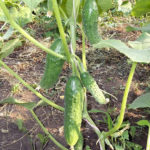
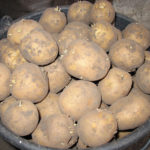
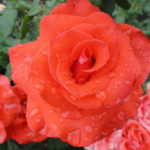
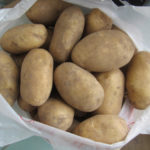
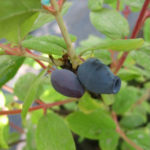
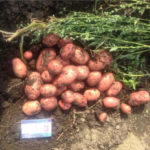



It was purchased in the garden center during the period of intensive filling of the site, when I did not think about the peculiarities of cultivation.As a result, I chose a place where she was ill - on an inclined area, the soil was washed away by downpours and the root suffered. In addition, in one of the winters, the lower branches froze on one side. It was decided to cut 20 cm from the bottom everywhere and in the future lead it like a small stem. Such pruning made it possible to create a small section of a multi-level garden next to Konika - junipers and mountain weeds went down.